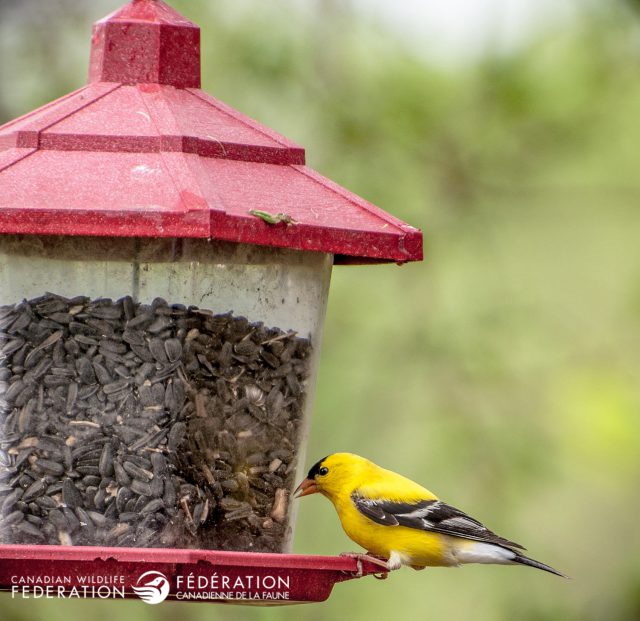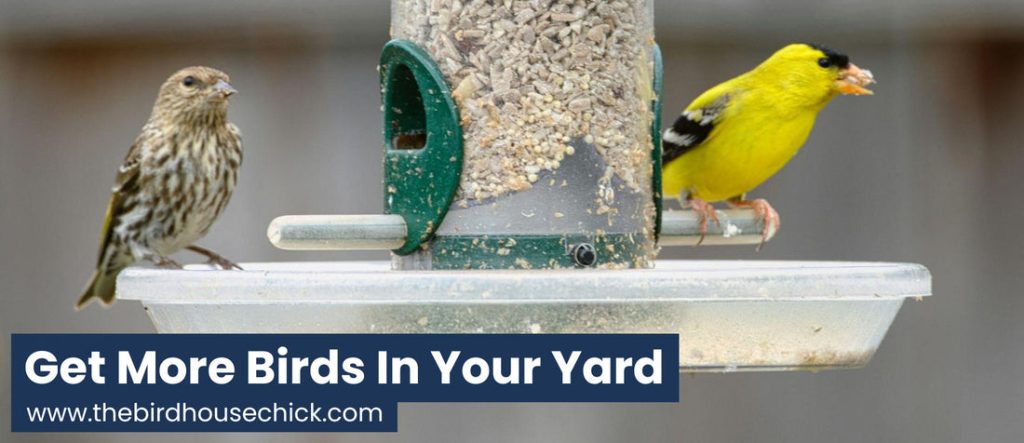Imagine waking up to the melodic chorus of songbirds right outside your window. The flutter of wings and vibrant colors can transform your yard into a lively sanctuary, a peaceful retreat amidst the hustle of daily life.
If you’re wondering how to attract more birds to your yard, you’re in the right place. By understanding what birds need and enjoy, you can create an inviting environment that draws them in. This article will guide you on how to turn your outdoor space into a bird haven, offering simple, actionable steps that promise delightful results.
Stay with us, and you’ll soon discover the joy of a yard filled with the beauty and song of birds.

Credit: blog.cwf-fcf.org
Choose The Right Plants
Choosing the right plants is key to inviting a variety of birds to your yard. Plants provide food, shelter, and nesting spots, making your space a bird-friendly haven. Selecting species that meet these needs can transform your yard into a lively bird sanctuary.
Native Flowers And Shrubs
Native plants are naturally adapted to your local climate and soil. Birds are familiar with these plants and often rely on them for food and cover. Adding native flowers and shrubs like coneflowers, black-eyed Susans, or elderberries gives birds easy access to nectar, seeds, and insects.
Have you noticed how birds quickly find native plants in your garden? That’s because these plants offer the right kind of nourishment they’ve evolved with. Plus, they require less maintenance, saving you time and effort.
Fruit-bearing Trees
Fruit-bearing trees attract birds looking for fresh meals throughout the year. Trees like crabapple, serviceberry, and dogwood produce berries that many bird species love. These fruits provide vital energy, especially during migration and colder months.
Planting a few fruit trees can make a big difference. You’ll see a noticeable increase in bird visits as they come to feast on the natural buffet. It’s a simple way to create a dependable food source your feathered friends will appreciate.
Seasonal Blooms
Including plants that bloom in different seasons ensures a steady supply of food and shelter. Early bloomers like crocuses feed birds emerging from winter, while late bloomers like asters provide resources before winter returns. This variety keeps birds coming back year-round.
Think about your yard’s timeline. What flowers or shrubs bloom in spring, summer, and fall? Planning seasonal blooms means your yard will never be empty of bird-friendly plants. It’s like offering a continuous invitation to your winged visitors.
Provide Food Sources
Providing food sources is key to attracting birds to your yard. Birds visit places where they find easy food. A variety of food options can meet different bird preferences. This encourages more types of birds to visit and stay longer.
Feeders And Seeds
Use different feeders to offer various seeds. Tube feeders are great for small birds like finches. Platform feeders attract larger birds like cardinals. Choose high-quality seeds such as sunflower, millet, and nyjer. Keep feeders clean to prevent diseases. Place feeders in safe spots away from predators.
Natural Insects
Insects are a natural food source for many birds. Avoid using pesticides to keep insects healthy. Grow native plants that attract insects like caterpillars and beetles. Leaf litter and mulch can also support insect life. Birds enjoy catching insects on leaves and tree bark.
Avoiding Harmful Foods
Some foods can harm birds and should be avoided. Do not feed bread, salty snacks, or processed foods. These can cause health problems and malnutrition. Avoid moldy or spoiled food, as it can make birds sick. Always provide fresh and clean food to keep birds healthy.
Create Safe Water Spots
Creating safe water spots is essential for attracting birds to your yard. Birds need water not only to drink but also to bathe and cool off. By providing clean, accessible water sources, you invite a variety of feathered visitors to make your yard their favorite stop.
Birdbaths And Ponds
Birdbaths are a simple way to offer water, but their design matters. Choose shallow basins with gentle slopes so birds can easily land and splash around without risk. If you have space, a small pond can attract more species, especially if surrounded by native plants that provide shelter.
Think about placing your water spot in a quiet, sheltered area. Avoid locations too close to dense shrubs where predators might hide. You want birds to feel safe while they drink and bathe.
Moving Water Features
Birds are drawn to the sound and sight of moving water. Adding a small fountain or dripper to your birdbath can increase visits dramatically. Moving water also helps prevent mosquitoes from breeding, keeping your water source healthier.
You don’t need a big setup; even a simple solar-powered bubbler can make a difference. Have you noticed how your own backyard feels livelier with the gentle sound of trickling water? Birds feel the same way.
Water Maintenance Tips
Keeping water clean is crucial. Dirty or stagnant water can repel birds and spread disease. Change the water every two to three days and scrub your birdbath with a brush to remove algae and dirt.
During hot weather, check water levels daily. Adding fresh water regularly ensures birds always have a reliable source. If you spot leaves or debris, remove them promptly to maintain a safe and inviting water spot.

Credit: www.thebirdhousechick.com
Offer Shelter And Nesting Areas
Providing shelter and nesting areas is essential if you want birds to make your yard their home. Birds need safe places to rest, hide from bad weather, and raise their young. Creating these spaces will encourage a variety of species to visit and stay longer.
Birdhouses And Nesting Boxes
Installing birdhouses or nesting boxes offers birds a secure spot to lay eggs and raise chicks. Different birds prefer different sizes and shapes, so research what species are common in your area.
- Place boxes at varying heights to attract different birds.
- Use untreated wood to keep the environment safe for birds.
- Ensure proper ventilation and drainage to keep nests dry.
I once added a few nesting boxes in my backyard and noticed bluebirds taking up residence within weeks. You might be surprised how quickly birds will trust a well-placed house.
Dense Shrubs And Trees
Dense shrubs and trees provide natural cover and nesting spots for birds. Evergreens are particularly good because they offer protection year-round.
Planting native bushes and trees not only gives birds shelter but also attracts insects they feed on. Think about layering your plants with tall trees, medium shrubs, and low ground cover to create a welcoming habitat.
Avoiding Predators
Creating shelter isn’t enough if predators can easily reach bird nests. Cats, snakes, and even larger birds can threaten your feathered visitors.
- Place birdhouses away from easy access points for predators.
- Use baffles on poles to prevent climbing animals.
- Keep your yard tidy to reduce hiding spots for snakes.
Have you noticed how some yards never seem to attract birds despite feeders and water? Predators might be the unseen reason. Protecting your birds will help them feel safe enough to stay.
Maintain A Bird-friendly Environment
Creating a bird-friendly environment in your yard invites more feathered visitors and supports their well-being. It’s not just about putting out feeders; it’s about shaping a safe, healthy space where birds feel welcome every day. Small changes in how you care for your yard can make a big difference in attracting a variety of birds.
Limit Pesticide Use
Birds rely on insects for food, especially during nesting season. Using pesticides can drastically reduce the insect population, cutting off a vital food source. Instead, try natural pest control methods like introducing ladybugs or planting pest-repellent herbs.
I once stopped using chemical sprays in my garden, and within weeks, I noticed more birds visiting to feed on the insects. This simple switch helped create a balanced ecosystem where birds can thrive.
Keep Cats Indoors
Cats are natural hunters and can pose a serious threat to backyard birds. Keeping your cats indoors protects birds from sudden attacks and helps maintain a peaceful environment. If you want your cat to enjoy the outdoors, consider a secure cat enclosure that keeps birds safe.
Have you thought about how many birds might avoid your yard because of roaming cats? Making this change shows birds that your yard is a safe place to visit and stay.
Regular Yard Cleanup
Cleaning up fallen fruit, leaves, and debris prevents pests and diseases that can harm birds. Regularly raking leaves and removing trash keeps your yard inviting and healthy for birds and other wildlife. However, leaving some leaf litter and dead wood can provide natural shelter and food sources.
In my experience, maintaining a tidy yard while preserving natural elements creates a balanced habitat. Birds return more often when they find both safety and resources in your space.
Attract Specific Bird Species
Attracting specific bird species to your yard requires understanding their unique needs. Different birds prefer different foods, shelter, and water sources. By tailoring your yard, you can invite your favorite birds to visit often. Focus on providing the right plants, feeders, and habitat for each type.
Hummingbird Tips
Hummingbirds love bright flowers and sugary nectar. Plant tubular red or orange flowers like trumpet vine and bee balm. Use a hummingbird feeder filled with fresh sugar water. Mix four parts water to one part sugar, no red dye needed. Keep feeders clean to prevent mold. Place feeders in sunny spots near shrubs for shelter.
Attracting Songbirds
Songbirds enjoy a variety of seeds and fruits. Offer black oil sunflower seeds, nyjer, and millet in different feeders. Plant native berry bushes like elderberry and serviceberry. Provide dense shrubs or trees for nesting and protection. Fresh water in a birdbath attracts them too. Change water often to keep it clean.
Welcoming Waterfowl
Waterfowl need water sources like ponds or large birdbaths. Create shallow edges for easy access. Plant native aquatic plants such as cattails and water lilies. Offer cracked corn, oats, or duck pellets on the shore. Avoid bread, as it harms their health. Keep the area quiet and safe from predators.

Credit: www.youtube.com
Frequently Asked Questions
What Types Of Bird Feeders Attract More Birds?
Tube feeders attract small songbirds, while platform feeders suit larger birds. Suet feeders draw woodpeckers. Choose feeders based on local bird species to maximize visits.
How Can I Create A Bird-friendly Yard Habitat?
Plant native trees and shrubs for shelter and food. Provide fresh water sources and avoid pesticides. A diverse habitat supports various bird species year-round.
What Foods Are Best For Attracting Wild Birds?
Offer sunflower seeds, nyjer seeds, and suet. Fruits like berries also attract birds. Avoid bread, which lacks nutrition and can harm birds.
How Important Is Water For Attracting Birds?
Water is essential for drinking and bathing. A shallow birdbath with clean water will attract more birds. Change water regularly to prevent disease.
Conclusion
Attracting birds to your yard brings nature close and joy daily. Plant native flowers and trees for food and shelter. Provide fresh water with a birdbath or small pond. Place feeders in safe, quiet spots to welcome visitors. Keep your yard clean to protect birds from harm.
Watch and enjoy the colorful, lively guests outside your window. Small efforts create a peaceful, bird-friendly space anyone can enjoy. Start simple and see your yard come alive with birds soon.

